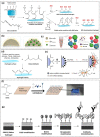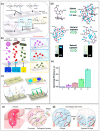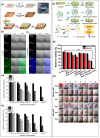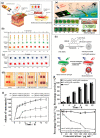Multifunctional Composite Hydrogels for Bacterial Capture, Growth/Elimination, and Sensing Applications
- PMID: 36222596
- PMCID: PMC9614723
- DOI: 10.1021/acsami.2c08582
Multifunctional Composite Hydrogels for Bacterial Capture, Growth/Elimination, and Sensing Applications
Abstract
Hydrogels are cross-linked networks of hydrophilic polymer chains with a three-dimensional structure. Owing to their unique features, the application of hydrogels for bacterial/antibacterial studies and bacterial infection management has grown in importance in recent years. This trend is likely to continue due to the rise in bacterial infections and antimicrobial resistance. By exploiting their physicochemical characteristics and inherent nature, hydrogels have been developed to achieve bacterial capture and detection, bacterial growth or elimination, antibiotic delivery, or bacterial sensing. Traditionally, the development of hydrogels for bacterial/antibacterial studies has focused on achieving a single function such as antibiotic delivery, antibacterial activity, bacterial growth, or bacterial detection. However, recent studies demonstrate the fabrication of multifunctional hydrogels, where a single hydrogel is capable of performing more than one bacterial/antibacterial function, or composite hydrogels consisting of a number of single functionalized hydrogels, which exhibit bacterial/antibacterial function synergistically. In this review, we first highlight the hydrogel features critical for bacterial studies and infection management. Then, we specifically address unique hydrogel properties, their surface/network functionalization, and their mode of action for bacterial capture, adhesion/growth, antibacterial activity, and bacterial sensing, respectively. Finally, we provide insights into different strategies for developing multifunctional hydrogels and how such systems can help tackle, manage, and understand bacterial infections and antimicrobial resistance. We also note that the strategies highlighted in this review can be adapted to other cell types and are therefore likely to find applications beyond the field of microbiology.
Keywords: active hydrogels; bacterial adhesion; bacterial capture elements; bioactive elements; functionalized hydrogels; hydrogel-embedded carriers; interfaced sensors; multifunctional hydrogels; therapeutic hydrogels.
Conflict of interest statement
The authors declare no competing financial interest.
Figures






References
-
- Kaith B. S.; Singh A.; Sharma A. K.; Sud D. Hydrogels: Synthesis, Classification, Properties and Potential Applications—A Brief Review. J. Polym. Environ 2021, 29, 3827–3841. 10.1007/s10924-021-02184-5. - DOI
-
- Mishra S.; Rani P.; Sen G.; Dey K. P.. Preparation, Properties and Application of Hydrogels: A Review. Gels Horizons: From Science to Smart Materials; Springer: 2018; pp 145–173.10.1007/978-981-10-6077-9_6. - DOI
Publication types
MeSH terms
Substances
LinkOut - more resources
Full Text Sources
Other Literature Sources
Medical

